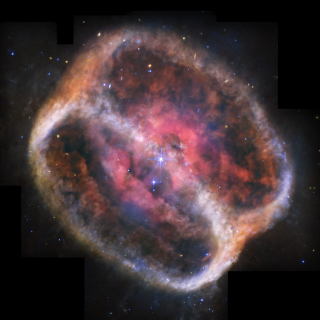Stars with masses between one and eight times the mass of the Sun evolve along the asymptotic giant branch (AGB) before ending their lives as white dwarfs. It is during this rapid but crucial phase when the stars expand to huge dimensions and cool down, losing a major fraction of their mass due to the strong stellar winds. The low temperature and high density of the winds provide ideal conditions for the condensation of dust grains in their circumstellar envelopes. The dust produced by the stars in their AGB phase and expelled into the interstellar medium is important for the lives of the galaxies, because this is an essential component for the formation of new stars, and also of planets. That is why characterising the type of dust (solid state organic components, or inorganic components) and the quantity of dust produced by these giant stars is very interesting to the astronomers. Here we have characterized for the first time a peculiar group of massive AGB stars situated in the Large Magellanic Cloud. Comparing the infrared observations made with the Spitzer Space Telescope (and predictions for the future James Webb Space Telescope, JWST) with the theoretical models, we have discovered that these stars have masses around 5 solar masses, were formed around 100 million years ago, and are poor in metals (such as iron, magnesium and silicon). Unexpectedly we have discovered that the infrared spectral energy distributions can be reproduced only if iron dust is the principal dust component of their circumstellar envelopes. This is uncommon around massive AGB stars. Before it was known that they mainly produced silicates, large quantities of dust rich in oxygen and silicon, as well as magnesium. But this finding is even more surprising if we consider the metal poor environment of the stars under study. In fact, in metal poor environments the complex nucleosynthesis within massive AGB stars is so advanced that it burns up almost all the magnesium and oxygen, necessary to form other types of dust, such as the silicates. This result is an important confirmation of the theory of iron dust in metal poor environments and the MIRI instrument on the upcoming JWST will be ideal for identifying this class of stars in other galaxies of the Local Group.
Infrared image of the Large Magellanic Cloud (LMC) as obtained with the Spitzer Space Telescope. Upper inset: the comparison between the Spitzer/IRS spectrum (black solid line) of the star SSID 4486 and the best fit theoretical spectrum of a 5 solar mass
Advertised on
Authors
E. Marini
F. Dell'Agli
M. Di Criscienzo
Domingo Aníbal
García Hernández
L. Mattsson
P. Ventura
References
2019 ApJ 871 L16



